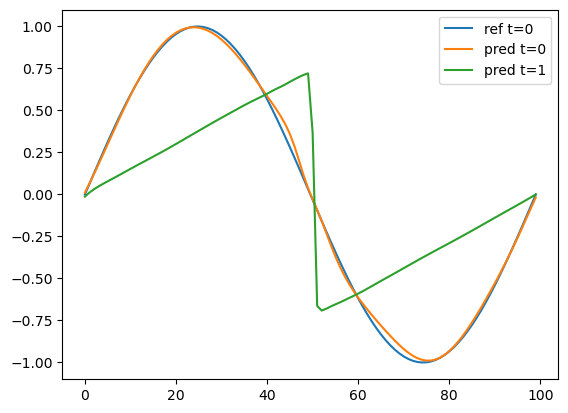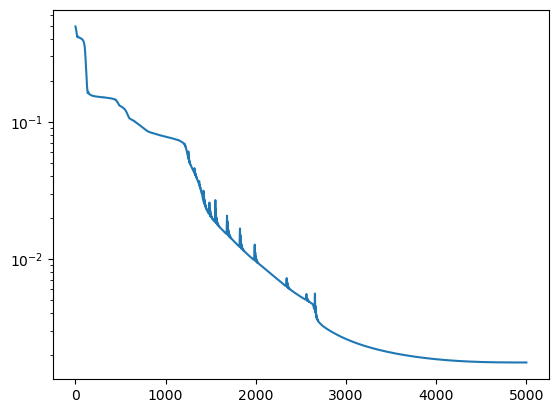PINN for burgers equation
Contents
PINN for burgers equation#
我们希望使用PINN求解如下的方程。
\[\begin{split}
\begin{aligned}
\partial_t u + u \, \partial_x u - (0.01/\pi) \, \partial_{xx} u &= 0, \quad &&\quad (t,x) \in (0,1] \times (-1,1),\\
u(0,x) &= - \sin(\pi \, x), \quad &&\quad x \in [-1,1],\\
u(t,-1) = u(t,1) &= 0, \quad &&\quad t \in (0,1].
\end{aligned}
\end{split}\]
步骤基本上可以分成:
生成数据
构建神经网络作为解的逼近
构建损失函数
训练网络
可视化结果
我们下面首先导入必备的python库
import torch
import torch.nn as nn
import math
from matplotlib import pyplot as plt
device='cuda' if torch.cuda.is_available() else 'cpu'
生成数据#
下面我们首先生成数据。
使用PINN求解正问题的数据主要就是初值和边值。还要生成内部采样点的坐标。这些数据既可以在边训练边生成,也可以提前生成好,我们这里选取提前生成好的形式。
对于初值,我们要生成若干\((x,t,u)\)的数据对,满足 \(u(0,x) = - \sin(\pi \, x), \quad x \in [-1,1]\). 这里我们选择了在边界等距采样,实际上也可以换成随机均匀采样。
xmin=-1
xmax=1
nx=100
tmin=0
tmax=1
nt=100
n_samples=10000
nu=0.01/math.pi
IV_x=torch.linspace(xmin,xmax,nx).to(device=device)
IV_t=torch.zeros_like(IV_x).to(device=device)
IV_u=-torch.sin(math.pi*IV_x).to(device=device)
对于边界条件,我们依据 \( u(t,-1) = u(t,1) = 0,\quad t \in (0,1] \) 分别生成若干左边界和右边界的数据点。
BV_xL=-torch.ones(nt)
BV_tL=torch.linspace(tmin,tmax,nt)
BV_uL=torch.zeros_like(BV_xL)
BV_xR=torch.ones(nt)
BV_tR=torch.linspace(tmin,tmax,nt)
BV_uR=torch.zeros_like(BV_xR)
BV_x=torch.cat([BV_xL,BV_xR]).to(device=device)
BV_t=torch.cat([BV_tL,BV_tR]).to(device=device)
BV_u=torch.cat([BV_uL,BV_uR]).to(device=device)
然后我们再生成区域内部的采样点坐标,这些点只有\((x,t)\),没有\(u\)。
IN_x=torch.rand((n_samples,))*2-1
IN_t=torch.rand((n_samples,))
IN_x=IN_x.requires_grad_().to(device=device)
IN_t=IN_t.requires_grad_().to(device=device)
我们可视化一下生成的数据点分布。
plt.scatter(IN_x.cpu().detach().numpy(),IN_t.cpu().detach().numpy(),label="Inner Point")
plt.scatter(IV_x.cpu().detach().numpy(),IV_t.cpu().detach().numpy(),label="Initial Value")
plt.scatter(BV_x.cpu().detach().numpy(),BV_t.cpu().detach().numpy(),label="Boundary Value")
plt.legend()
plt.xlabel("x")
plt.ylabel("t")
Text(0, 0.5, 't')

构建网络#
我们构建一个全连接网络用来作为方程解的拟设(Ansatz)。
class FCN(nn.Module):
def __init__(self,neurons,activation):
super().__init__()
self.act=activation
self.linears = nn.ModuleList([nn.Linear(neurons[i], neurons[i+1]) for i in range(len(neurons)-1)])
def forward(self,x):
for layer in self.linears[:-1]:
x=layer(x)
x=self.act(x)
x=self.linears[-1](x)
return x
class Ansatz(nn.Module):
def __init__(self):
super().__init__()
self.net=FCN([2,20,20,20,20,20,20,1],torch.sin)
def forward(self,x,t):
xt=torch.stack([x,t],dim=-1)
y=self.net(xt)
return y
构建损失函数#
损失函数分为3部分,分别是初值的损失函数、边值的损失函数,以及内点的残差损失函数。
我们先定义内点的损失函数,下面是比较传统的使用pytorch计算导数的方法,并基于此构建损失函数。
def pinn_loss(x,t,net,nu):
u=net(x,t)[...,0]
du_dt=torch.autograd.grad(u.sum(),t,create_graph=True)[0]
du_dx=torch.autograd.grad(u.sum(),x,create_graph=True)[0]
ddu_dxx=torch.autograd.grad(du_dx.sum(),x,create_graph=True)[0]
loss=du_dt+u*du_dx-nu*ddu_dxx
return loss.square().mean()
PyTorch最新的版本推出了函数变换功能,可以更方便的获取导数。我推荐使用torch.func相关的API进行符号求导,更加自由。
def pinn_loss(x,t,net,nu):
u=net(x,t)[...,0]
du=torch.func.jacrev(net,argnums=(0,1))
du_dx,du_dt=torch.vmap(du)(x,t)
ddu=torch.func.jacrev(lambda x,t:du(x,t)[0],argnums=(0,))
ddu_dxx,=torch.vmap(ddu)(x,t)
du_dx=du_dx.reshape(u.shape)
du_dt=du_dt.reshape(u.shape)
ddu_dxx=ddu_dxx.reshape(u.shape)
loss=du_dt+u*du_dx-nu*ddu_dxx
return loss.square().mean()
下面则是定义关于初值和边值的误差
def mse_loss(x,y):
return (x.flatten()-y.flatten()).square().mean()
def initial_loss(x,t,net,u):
u_pred=net(x,t)
loss=mse_loss(u_pred,u)
return loss
def boundary_loss(x,t,net,u):
u_pred=net(x,t)
loss=mse_loss(u_pred,u)
return loss
训练网络#
在训练网络的过程中,我们使用Adam优化器和CosineAnnealingWarmRestarts学习率调整器,并且记录每一步的总损失函数。
model=Ansatz().to(device=device)
optimizer=torch.optim.Adam( model.parameters(), lr=1e-3)
scheduler=torch.optim.lr_scheduler.CosineAnnealingWarmRestarts(optimizer,5000,2)
epochs=5000
loss_hist=[]
for i in range(1,1+epochs):
optimizer.zero_grad()
loss_IV=initial_loss(IV_x,IV_t,model,IV_u)
loss_BV=boundary_loss(BV_x,BV_t,model,BV_u)
loss_pinn=pinn_loss(IN_x,IN_t,model,nu)
loss_sum=loss_IV+loss_BV+loss_pinn
loss_hist.append(loss_sum.item())
loss_sum.backward()
optimizer.step()
scheduler.step()
if i%1000==0:
print(f"{i}:{loss_IV:.2e},{loss_BV:.2e},{loss_pinn:.2e}")
1000:4.65e-02,1.02e-04,3.14e-02
2000:4.92e-03,8.08e-05,5.44e-03
3000:1.01e-03,2.09e-05,1.57e-03
4000:6.84e-04,2.07e-05,1.15e-03
5000:6.44e-04,2.04e-05,1.09e-03
可视化训练结果#
下面画出了t=0时的初值和网络预测值,以及t=1时的网络预测值。
IV_x=torch.linspace(xmin,xmax,nx).to(device=device)
IV_t=0.0*torch.ones_like(IV_x).to(device=device)
VA_x=torch.linspace(xmin,xmax,nx).to(device=device)
VA_t=1.0*torch.ones_like(IV_x).to(device=device)
with torch.no_grad():
VA_pred=model(VA_x,VA_t)
IV_pred=model(IV_x,IV_t)
plt.plot(IV_u.detach().cpu().numpy(),label='ref t=0')
plt.plot(IV_pred.detach().cpu().numpy()[...,0],label='pred t=0')
plt.plot(VA_pred.detach().cpu().numpy()[...,0],label='pred t=1')
plt.legend()
<matplotlib.legend.Legend at 0x7f0d18f8ceb0>

下面则是训练过程中误差的下降曲线
plt.plot(loss_hist)
plt.yscale('log')



